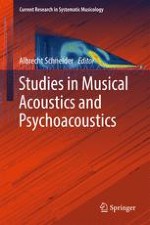2017 | OriginalPaper | Buchkapitel
Methods in Neuromusicology: Principles, Trends, Examples and the Pros and Cons
verfasst von : Christiane Neuhaus
Erschienen in: Studies in Musical Acoustics and Psychoacoustics
Aktivieren Sie unsere intelligente Suche, um passende Fachinhalte oder Patente zu finden.
Wählen Sie Textabschnitte aus um mit Künstlicher Intelligenz passenden Patente zu finden. powered by
Markieren Sie Textabschnitte, um KI-gestützt weitere passende Inhalte zu finden. powered by
